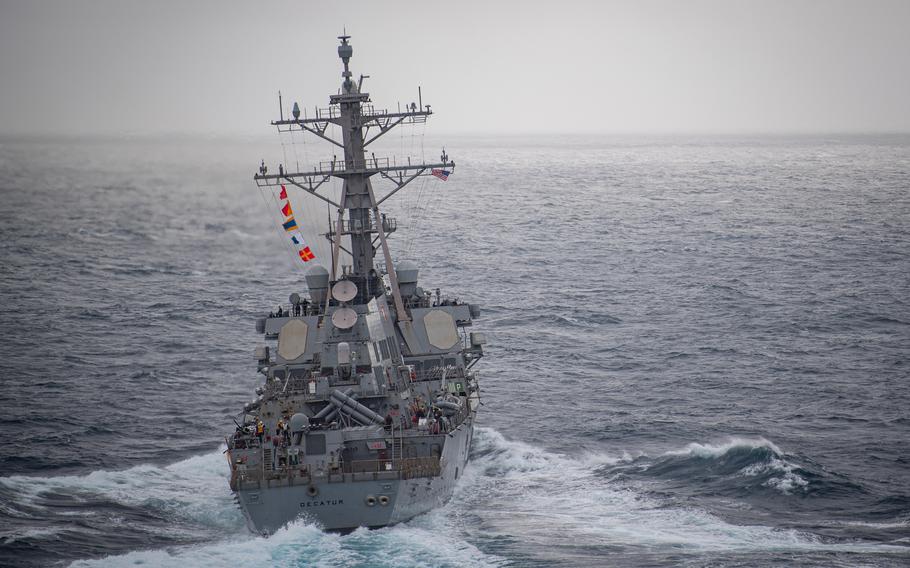
The Arleigh Burke-class, guided-missile destroyer USS Decatur steams in the South China Sea on Jan. 28, 2023. (Hannah Kantner/U.S. Navy)
WASHINGTON — The Navy’s warships have been spending less time at sea and more time under costly and lengthy repairs since 2011, according to a government watchdog report released Tuesday.
A review of 151 surface warships by the Government Accountability Office showed worsening maintenance delays, more breakdowns requiring repairs and a rising number of working ship parts removed and used elsewhere due to parts shortages in the industry supply chain.
“We have made dozens of recommendations to address these issues, but the Navy has yet to fully implement them all,” the agency wrote.
Navy officials argued in the report that a decrease in time at sea is not necessarily bad and does not always reflect a ship’s inability to perform its mission. They also explained the allocation of “steaming hours,” or a ship’s hours at sea, is driven by budgetary concerns and the cost of fuel.
But the Government Accountability Office said persistent ship sustainment issues have prevented the Navy from reaping the full benefit of its forces and contributed to significant readiness challenges during the past decade.
Congressional lawmakers have pressed the service to build a fleet powerful enough to counter China as it expands its influence in the Indo-Pacific region and eyes a possible invasion of Taiwan. China’s Navy is now the largest in the world, according to the Pentagon, while the U.S. Navy’s 293-vessel fleet falls short of the 350-ship force desired by some lawmakers.
Navy officials told the GAO that significant maintenance backlogs influenced their decision last year to seek the recommissioning of nine ships before the end of their service life. Congress has routinely stepped in to prevent certain early vessel retirements, most recently the guided-missile cruiser USS Vicksburg.
“Congress is willing to build more ships than the Navy,” Rep. Rob Wittman, R-Va., wrote in an editorial last year. Wittman was named vice chairman of the House Armed Services Committee last week.
Maintenance delays per ship have multiplied since 2011, increasing from five days on average to an average of 19 days in 2021. Maintenance costs grew by $1.2 billion during the same period, according to the report.
Navy officials said growth in the magnitude of previously planned work and the discovery of the need for new work caused maintenance delays for all nine surface ship classes reviewed by the agency.
The Navy spent about $17 billion during fiscal 2020 to operate and sustain the 10 ship classes assessed in the report, a $2.5 billion increase from fiscal 2011. The selected ship classes represent about half of the Navy’s ship battle force.
Though the Navy has added 33 ships to those classes since 2011, the number of hours at sea declined and became more expensive, according to the report.
The GAO said the service’s growing reliance on pulling working parts from ships for installation in ships under repair contributed to the higher costs. Cannibalization of parts increases workloads, lowers morale and takes expensive weapons systems out of service for long periods of time, according to the report.
The Arleigh Burke-class of destroyers saw seven more cannibalizations per ship in fiscal 2022 than in fiscal 2011. The 68 ships in the class also had 19 more serious failure reports per ship than a decade ago, according to the report. Maintenance costs increased by $661 million for the Arleigh Burke class.
Analysts with the Government Accountability Office said the Navy has generally agreed with their recommendations to improve ship sustainment but is failing to fully or accurately track operational and materiel availability. The Navy also needs to establish measures to manage depot maintenance backlogs, better track data on maintenance periods and take steps to ensure new ships are reliable, the agency wrote.